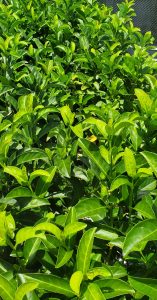
There is a good reason why Charlotte County landscapes are full of Sweet Viburnum. Sweet Viburnum, a type of shrub and small tree, are very versatile in that they not only make a great hedge material, but can also be trained into small, neat trees. This quick-growing woody plant will add an attractive and utilitarian feature to any yard.
As a general-purpose shrub, Sweet Viburnum is most often used in our area to develop hedges. With green leaves four to eight inches long, this broadleaf evergreen also has the added feature of fragrant spring flowers and red to black berries favored by wildlife. For a formal appearance, prune so that the top of the hedge is narrow, and the base is wide so that all portions of the hedge can get sun equally. This trapezoidal shape helps grow a full, functional hedge.
Sweet Viburnum can also be trained into a single or multi-stemmed tree-form specimen. In fact, given the room, a Sweet Viburnum will grow up to twenty-five feet tall with up to a twenty-five-foot spread. The canopy of the tree is very compact and minimal pruning is needed other than for lower branch removal to show off the trunk. The nature of this smaller tree also allows for under-wire planting. Besides its use as a formal hedge and small tree, consider the Sweet Viburnum for making an excellent informal privacy screen.
Once established, the Sweet Viburnum is highly drought-tolerant and fully hardy for our area. One important consideration to keep in mind – it does not do well in salty environments. Full sun sites are preferred as they will keep the shrub and/or tree from becoming thin and open as may be experienced in shaded areas. Several cultivars exist such as ‘Emerald Lustre’ which has large leaves and ‘Nanum’ which is dwarf in size. You will generally find Sweet Viburnum readily available at most garden centers. If you need more, they can be propagated by cuttings or various layering techniques.
Viburnum odoratissimum, aka Sweet Viburnum, is both a Florida-Friendly Landscaping™ approved woody ornamental, and not a problem species according to the UF/IFAS Assessment of Non-Native Plants in Florida’s Natural Areas – all important characteristics.
Sweet Viburnum are indeed worthy of your consideration as landscape subjects with many uses and landscape appeal – it is one sweet shrub! For more information on all types of similar woody plants suitable for Southwest Florida, or to ask a question, you can also call the Master Gardener Volunteer Helpdesk on Mondays, Wednesdays, and Fridays from 1 to 4 pm at 764-4340 for gardening help and insight into their role as an Extension volunteer. Ralph E. Mitchell is the Director/Horticulture Agent for UF/IFAS Extension Charlotte County. He can be reached at 941-764-4344 or ralph.mitchell@charlottecountyfl.gov. Connect with us on social media. Like us on Facebook @CharlotteCountyExtension and follow us on Instagram @ifascharco.
Gilman, E. F. & Watson, D. G. ( 2014) Viburnum odoratissimum, Sweet Viburnum. The University of Florida Extension Service, IFAS.
The Florida-Friendly Landscaping™ Guide to Plant Selection & Landscape Design (2022) The University of Florida Extension Services.
UF/IFAS Assessment of Non-Native Plants in Florida’s Natural Areas. (2024). The University of Florida Extension Service, IFAS.
 3
3
